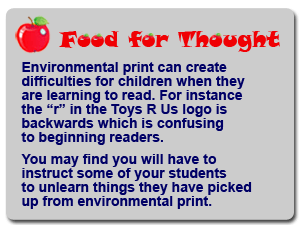Connections to Reading
The words we use are the labels for our experiences or concepts. Therefore, development of oral language (the labels) for experiences (the concepts) is crucial for literacy development because written words are symbols for concepts. Literacy is decoding the symbols on the page (representations of what was said or our labels for concepts). Children learn fairly early that written symbols have a connection to specific places, objects, and experiences. 
Through repeated exposure to “environmental print” on signs, items, and packaging, children begin to connect with the concept that symbols represent things. For many children this “Golden Rule” is the “Golden Arches.” Children begin to “read” things, such as the McDonald's logo and other environmental print, long before they can articulate the words or name letters of the alphabet.
A good initial strategy for teaching reading is to capitalize on a child’s understanding of environmental print (the concepts and the oral language attached to it) when teaching sight words, letters of the alphabet, onset and rime, and other literacy skills. One way to teach these skills is to create environmental print books using the language experience approach (which you will learn more about later).
Using this approach is also effective in teaching beginning reading to children and adult English language learners. When using this method it is important to consider the culture references and experiences of each student. For instance, students who are newly arrived from other countries may not recognize environmental print. Students must also have sufficient background information, the oral language vocabulary attached to that background information, as well as decoding skills to understand what a text is supposed to communicate.
